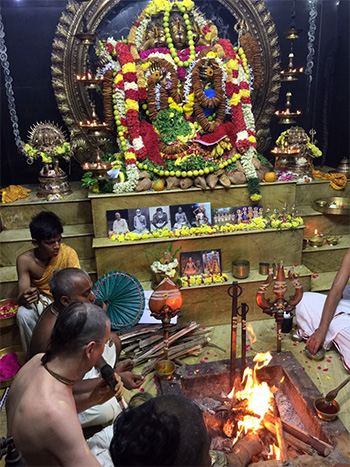Question: I would like to know more about Nada-Anusadhana. Specifically, is the Ajapa Gayatri Mantra “Hamsah Soham” mentioned in this essay the complete mantra, and do you have to chant it contiguously without stopping, or will chanting in installments over a few days work as well, and do you chant silently, or audibly, or even loudly? Are there any other details one should know in order to perforn this sadhana properly?
The ‘hamsah soham’ mantra belongs to the category of nada upasana. There are three categories of upasana, namely pranava, nada and shabda. In pranava upasana the mantra is recited internally. In nada upasana the mantra is recited with the movement of the lips, but in an almost inaudible sound. And in shabda upasana the mantra is recited loudly. Ultimately the mantra is meant to be recited continuously. Actually you do not recite this mantra, but rather the mantra becomes your breath. When one attains siddhi one no longer breaths, but only recites the mantra.
Of course in the beginning it is not possible to recite the mantra continuously, so one should do it in installments. Fix a time period each day that you can perform the mantra sadhana. Sit peacefully and meditate while reciting the mantra with your breath. As you goe on, you may increase the length of meditation and also begin to recite the mantra while carrying on your daily duties.
Hamsah is the actual mantra, and it is reversed when one exhales, forming so ‘ham. The original source of the mantra is from the Upanishads in the verse: sacidananda svarupo ‘ham sivo ‘ham sivo ‘ham. For sadhana the verse is condensced to “hamsah soham”. In meditation one should identify oneself as qualitatively one with Brahman.
Generally this sadhana is practiced by Shaivites or Avadhutas, but in recent times it has been adopted by various yoga paths, since it is connected with the breathing (pranayama). The Avadhutas who practice this sadhana are called as ‘hamsas”.
As one advances towards perfection in this sadhana one will experience many things. One will begin to hear sounds, such as the sound of the ocean, the sound of a vina, or a tingling sound. At first these sounds will be internally caused by one’s own body, but they represent cosmic factors linked with each body. The sadhaka should just ignore the sounds and continue his sadhana and meditation.
Receive our daily email newsletter on Hinduism, Yoga, Meditation, Ayurveda and Natural Healing.






